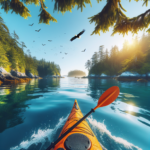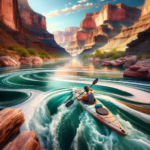Kayaking in Glacier Bay, Alaska, USA
Introduction to Kayaking
Kayaking is a popular outdoor activity that offers a unique blend of adventure, exercise, and a close connection with nature. Whether you’re paddling through serene lakes, navigating swift rivers, or exploring coastal waters, kayaking provides an exhilarating experience that appeals to both beginners and seasoned adventurers. The sport has grown in popularity over the years, thanks to its accessibility and the sheer joy it brings to those who partake in it.
In this article, we will spotlight the unique features of Kayaking in Glacier Bay, Alaska, USA, a destination that stands out for its breathtaking scenery and diverse wildlife. We’ll explore why this location is a must-visit for kayaking enthusiasts and provide detailed information to help you plan your trip. From the best spots to kayak to safety regulations and environmental considerations, we’ve got you covered.
Kayaking in Glacier Bay, Alaska, USA, offers a unique experience that combines the thrill of paddling with the awe-inspiring beauty of one of the most pristine natural environments in the world. The bay is home to towering glaciers, abundant marine life, and stunning landscapes that make every kayaking trip an unforgettable adventure. Whether you’re looking to challenge yourself or simply enjoy the tranquility of nature, Glacier Bay has something for everyone.
So, grab your paddle and get ready to explore the wonders of Kayaking in Glacier Bay, Alaska, USA. This article will guide you through everything you need to know to make the most of your kayaking adventure in this incredible destination.
Overview of Kayaking in Glacier Bay, Alaska, USA
Glacier Bay, located in southeastern Alaska, is a stunning natural wonder that offers some of the best kayaking experiences in the world. The bay is part of the Glacier Bay National Park and Preserve, a UNESCO World Heritage Site known for its dramatic landscapes, including towering glaciers, rugged mountains, and lush forests. The park covers over 3.3 million acres, providing endless opportunities for exploration and adventure.
The climate in Glacier Bay is characterized by cool temperatures and high levels of precipitation, with the summer months offering the most favorable conditions for kayaking. The weather can be unpredictable, so it’s essential to be prepared for sudden changes. The best time to visit is from late May to early September when the days are longer, and the weather is relatively mild.
Accessing Glacier Bay is relatively straightforward, with the nearest town, Gustavus, serving as the gateway to the park. Visitors can reach Gustavus by air or ferry from Juneau, the capital of Alaska. Once in Gustavus, you can take a short boat ride or a scenic flight to reach the park’s visitor center at Bartlett Cove, where most kayaking trips begin.
Historically, Glacier Bay has been a significant area for the indigenous Tlingit people, who have lived in the region for thousands of years. The bay’s rich cultural heritage adds another layer of depth to the kayaking experience, allowing visitors to connect with the area’s history and traditions while exploring its natural beauty.
Kayaking Conditions in Glacier Bay, Alaska, USA
Glacier Bay offers a diverse range of water conditions that cater to kayakers of all skill levels. The bay itself is a vast expanse of protected waters, making it an ideal location for both beginners and experienced paddlers. The calm, sheltered waters of Bartlett Cove are perfect for those new to kayaking, while the more challenging conditions further into the bay provide excitement for seasoned adventurers.
The weather in Glacier Bay can vary significantly throughout the year, with the summer months offering the most stable conditions for kayaking. During this time, temperatures typically range from 45°F to 65°F, and daylight hours are extended, providing ample time for exploration. However, it’s essential to be prepared for rain and sudden weather changes, as the region is known for its unpredictable climate.
Tides and currents play a crucial role in the kayaking experience in Glacier Bay. The bay experiences significant tidal fluctuations, with tides rising and falling by as much as 25 feet. Understanding the tide schedule is essential for planning your trip and ensuring a safe and enjoyable experience. Additionally, the bay’s currents can be strong, particularly near the glaciers, so it’s important to be aware of your surroundings and paddle with caution.
Environmental factors such as wind and ice conditions can also impact kayaking in Glacier Bay. Wind can create choppy waters and make paddling more challenging, while icebergs and floating ice can pose hazards, particularly near the glaciers. Always check the weather forecast and consult with park rangers for the latest conditions before setting out on your kayaking adventure.
Top Spots for Kayaking in Glacier Bay, Alaska, USA
Glacier Bay offers numerous kayaking spots, each with its unique features and attractions. One of the most popular areas is Bartlett Cove, located near the park’s visitor center. This sheltered cove provides calm waters and easy access to the surrounding forests and trails, making it an excellent starting point for beginners and families.
For those seeking a more challenging experience, Muir Inlet is a must-visit destination. This remote area is known for its stunning glaciers, including the Muir Glacier, which offers a breathtaking backdrop for your kayaking adventure. The inlet’s rugged terrain and abundant wildlife make it a favorite among experienced kayakers looking for a more immersive experience.
Another top spot is the West Arm of Glacier Bay, home to some of the park’s most impressive glaciers, including the Margerie and Johns Hopkins Glaciers. This area is known for its dramatic scenery and abundant marine life, including seals, sea otters, and humpback whales. The West Arm’s challenging conditions and stunning landscapes make it a popular choice for adventurous kayakers.
Finally, the Beardslee Islands offer a unique kayaking experience with their maze of channels and sheltered waters. This area is perfect for exploring at a leisurely pace, with opportunities to spot wildlife such as bald eagles, bears, and sea lions. The islands’ calm waters and scenic beauty make them an ideal destination for kayakers of all skill levels.
Safety and Regulations
Safety is paramount when kayaking in Glacier Bay, and it’s essential to be aware of the local regulations and guidelines. The National Park Service requires all kayakers to obtain a permit before embarking on their trip. Permits can be obtained at the park’s visitor center in Bartlett Cove and are necessary for both day trips and overnight excursions.
When it comes to safety gear, always wear a personal flotation device (PFD) and carry essential equipment such as a whistle, a waterproof map, and a first aid kit. It’s also advisable to bring a VHF radio or a satellite phone for emergency communication, as cell phone coverage is limited in the park. Additionally, dress in layers and wear waterproof clothing to stay warm and dry in the unpredictable weather conditions.
In case of an emergency, it’s crucial to know how to handle various situations. Familiarize yourself with basic rescue techniques, such as self-rescue and assisted rescue, and practice them regularly. If you encounter strong currents or rough waters, stay calm and paddle steadily to maintain control of your kayak. Always inform someone of your planned route and expected return time before setting out on your trip.
Respecting the park’s regulations and guidelines is essential for preserving the natural environment and ensuring a safe and enjoyable experience for all visitors. Follow Leave No Trace principles by packing out all trash, minimizing your impact on wildlife, and avoiding sensitive areas such as nesting sites. By adhering to these guidelines, you can help protect Glacier Bay’s pristine beauty for future generations to enjoy.
Amenities and Accommodations
Glacier Bay offers a range of amenities and accommodations to make your kayaking trip as comfortable and enjoyable as possible. In Bartlett Cove, you’ll find rental facilities that provide kayaks, paddles, and safety gear, making it easy to get started on your adventure. Additionally, guided tours are available for those who prefer to explore the bay with the expertise of a knowledgeable guide.
When it comes to accommodations, there are several options to suit different preferences and budgets. The Glacier Bay Lodge, located in Bartlett Cove, offers comfortable rooms with stunning views of the bay, as well as a restaurant and bar for dining and relaxation. For a more rustic experience, the Bartlett Cove Campground provides tent sites and basic amenities such as restrooms and bear-proof food storage lockers.
For those who prefer a more immersive experience, backcountry camping is allowed in designated areas throughout the park. This option allows you to explore the remote and pristine wilderness of Glacier Bay while enjoying the solitude and tranquility of nature. Be sure to obtain a backcountry permit and follow all regulations to ensure a safe and responsible camping experience.
In addition to kayaking, Glacier Bay offers a variety of recreational activities for visitors to enjoy. Hiking trails, such as the Bartlett River Trail and the Forest Loop Trail, provide opportunities to explore the park’s diverse landscapes on foot. Wildlife viewing, birdwatching, and photography are also popular activities, with the chance to spot species such as humpback whales, sea otters, and bald eagles.
Environmental Considerations
Preserving the natural habitats and wildlife of Glacier Bay is of utmost importance, and visitors are encouraged to practice eco-friendly kayaking practices. One of the key principles is to minimize your impact on the environment by following Leave No Trace guidelines. This includes packing out all trash, avoiding sensitive areas, and respecting wildlife by keeping a safe distance.
When kayaking in Glacier Bay, it’s essential to be mindful of the park’s unique ecosystems and the species that inhabit them. Avoid disturbing nesting sites, feeding areas, and other critical habitats, and always follow the park’s guidelines for wildlife viewing. By doing so, you can help protect the delicate balance of the park’s ecosystems and ensure that future generations can enjoy its natural beauty.
Conservation efforts are ongoing in Glacier Bay, with various projects aimed at preserving the park’s natural resources and promoting sustainable tourism. Visitors can support these efforts by participating in volunteer programs, donating to conservation organizations, and spreading awareness about the importance of protecting the environment. By taking an active role in conservation, you can contribute to the long-term preservation of Glacier Bay’s unique landscapes and wildlife.
In addition to following eco-friendly practices, it’s important to stay informed about any regulations or guidelines that may be in place to protect the environment. The National Park Service provides valuable information on responsible recreation and conservation efforts, so be sure to check their website or speak with park rangers for the latest updates. By staying informed and making responsible choices, you can help ensure that Glacier Bay remains a pristine and vibrant destination for generations to come.
Highlights
When comparing Kayaking in Glacier Bay, Alaska, USA with other popular kayaking destinations, several unique features stand out. One of the most notable aspects is the park’s incredible biodiversity, with a wide range of species that call Glacier Bay home. From humpback whales and sea otters to bald eagles and brown bears, the park offers unparalleled opportunities for wildlife viewing and photography.
Geographically, Glacier Bay is characterized by its dramatic landscapes, including towering glaciers, rugged mountains, and lush forests. The park’s unique glacial features, such as the Margerie and Johns Hopkins Glaciers, provide a stunning backdrop for kayaking adventures and set it apart from other destinations. The ever-changing ice formations and the sheer scale of the glaciers create a sense of awe and wonder that is hard to match.
Historically, Glacier Bay holds significant cultural importance for the indigenous Tlingit people, who have lived in the region for thousands of years. The park’s rich cultural heritage adds depth to the kayaking experience, allowing visitors to connect with the area’s history and traditions. This cultural significance, combined with the park’s natural beauty, makes Glacier Bay a truly unique destination for kayaking enthusiasts.
Data-driven analysis also highlights the park’s appeal, with visitor surveys consistently ranking Glacier Bay as one of the top kayaking destinations in the world. The combination of stunning scenery, diverse wildlife, and challenging conditions make it a favorite among kayakers of all skill levels. Whether you’re seeking adventure or tranquility, Glacier Bay offers an unparalleled experience that is sure to leave a lasting impression.
FAQ Section
- What is the best season to go kayaking in Glacier Bay? The best time to visit is from late May to early September when the weather is relatively mild, and daylight hours are extended.
- Are there beginner-friendly spots for kayaking in Glacier Bay? Yes, Bartlett Cove offers calm waters and easy access, making it an excellent starting point for beginners.
- What should I bring for a kayaking trip in Glacier Bay? Essential items include a personal flotation device (PFD), waterproof clothing, a whistle, a waterproof map, a first aid kit, and a VHF radio or satellite phone for emergency communication.
- Are kayak rentals available in Glacier Bay? Yes, rental facilities in Bartlett Cove provide kayaks, paddles, and safety gear.
- How can I participate in local conservation efforts? Visitors can support conservation by following Leave No Trace principles, participating in volunteer programs, donating to conservation organizations, and spreading awareness about environmental protection.
- Are guided kayaking tours available? Yes, guided tours are available for those who prefer to explore the bay with the expertise of a knowledgeable guide.
- What safety measures are in place for kayaking in Glacier Bay? Safety measures include obtaining a permit, wearing a PFD, carrying essential safety gear, and being aware of weather conditions, tides, and currents.
Final Thoughts
Kayaking in Glacier Bay, Alaska, USA is a premier destination for kayaking enthusiasts, offering a unique blend of stunning scenery, diverse wildlife, and challenging conditions. The park’s rich cultural heritage and commitment to conservation add depth to the experience, making it a truly unforgettable adventure. Whether you’re a beginner or an experienced paddler, Glacier Bay has something to offer everyone.
As you plan your trip, remember to respect local guidelines and conservation efforts to help preserve the park’s natural beauty for future generations. By practicing eco-friendly kayaking practices and staying informed about regulations, you can contribute to the long-term protection of this incredible destination.
In conclusion, Glacier Bay is a must-visit location for anyone passionate about kayaking and the great outdoors. Its unique features, from towering glaciers to abundant marine life, create an unparalleled experience that will leave you in awe. So grab your paddle and embark on an adventure of a lifetime in Glacier Bay, Alaska, USA.
We hope this article has provided you with valuable information and inspiration for your kayaking trip. Happy paddling!



